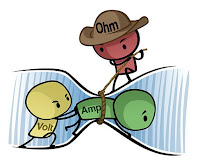Factors affecting gravitation acceleration(g). Complete hand written Derivation on Factors affecting 'g' Thank you! if ...
Thank you for making learning fun Happy Teachers day! 5-September-2019 Index: Coulomb's Law Principle of Superposit...
What is Coulomb's Law and Principle of Superposition
5-September-2019
- Coulomb's Law
- Principle of Superposition
The resultant force on any charge is equal to the vector sum of coulomb forces acting on individual charges.
Thank you! if you've got any question associated with this post please comment or for additional topics please comment.
Relation between universal constant (G) and gravitational acceleration (g) Suppose if, M = Mass of earth m = mass of falling...
Relation between universal gravitation constant (G) and gravitation acceleration (g)
Relation between universal constant (G) and gravitational acceleration (g)
Index: Newton's law of gravitation Acceleration due to gravity Newton's law of gravitation: Every particle in the univ...
Newton's law of gravitation
- Newton's law of gravitation
- Acceleration due to gravity
Newton's law of gravitation:
Two particle 'm1' and 'm2' the distance between them is 'R' and attraction force between them is 'F'.
- The attraction force between two particle is directly proportional to the product of their masses,
F α m1m2 (1)
- The attraction force between two particle is inversely proportional to the square root of there distance,
--According to (1) and (2)
If you face any kind of problem in my blog please comment below, so that i should take care of it in my next post.
At last stay healthy or safe and keep visiting at my blog.
Once again Thank you!! & best of luck by rohit.
Escape velocity and Escape energy Escape velocity When we project a body upward then after reaching a certain height, the body return b...
what is escape velocity and escape energy with deeply define definition and derivation
Escape velocity and Escape energy
Escape velocity
When we project a body upward then after reaching a certain height, the body return back due to gravitational attraction(g) of the earth. If we go increasing the initial velocity of he body, then it returns back after reaching greater and greater height. Ultimately(finally), at a certain velocity of projection the body will go out the gravitation field of the earth and will never return to the earth. This initial velocity of the body is called the 'escape velocity'.
in simple words- The minimum velocity with which a body should be projected from the surface of the earth so that it escapes the earth gravitational field called the escape velocity of the body.
Escape energy
The kinetic energy given to the body to project it with the escape velocity is called 'escape energy'.
Derivation:
Potential energy
The initial gravitational potential energy between two objects at some separations is:
where:
PEi is the initial gravitation potential energy.
Take a square root of each expression to get,
To find the escape velocity from the earth surface:
Thank you! if you've got any question associated with this topic or for additional topics comment, please review or comment truly.
redupoint Resistance All About Electric Resistance At this page, we have a tendency to fully...
factors upon which resistance depends
redupoint
All About Electric Resistance
At this page, we have a tendency to fully outline resistance & every important data regarding resistance
- resistance or resistance is a constant term
- factors upon which resistance depends
- resistivity
- temperature coefficient of resistance
- combination of resistance (SCR&PCR)
Electric Resistance is a property of a resistor to oppose the flow of electric current through it.
OR
The flow of free electrons is called current, and resistance is the obstruction in the path of flow of electron.
On removing proportionality sign (as a constant resistance comes),
v= volt,
I= current,
R= resistance (as a constant term)
If the potential difference (V) is 1 volt and current (I) is 1 ampere, then the Resistance (R) is 1 ohm
S.No.
|
Prefix
|
Symbol
|
Value in ohm (℧)
|
1.
|
Micro i.e. one millionth
|
10-6
| |
2.
|
Milli i.e. one thousandth
|
10-3
| |
3.
|
Kilo i.e. one thousand
|
103
| |
4.
|
Mega i.e. one million
|
106
|
- Length: The resistance R of a conductor is directly proportional to its length i.e. R directly proportional L
- Area of cross-section: The resistance R of a uniform conductor is inversely proportional to its area of cross-section (A),
- Nature of material: The resistance of a material conductor also depends on the nature of its material. In a simple word, a material having a large number of free electron, lesser is the electric resistance.
- Changes with temperature: i.e., resistance increase with the increase in temperature
The electrical resistivity of the material of a conductor is defined as the resistance of unit length and the unit cross-section area of the conductor.
The effect of temperature on resistance depends upon the type of material
- The resistance increases with increase in temperature (for metals)
- The resistance increase rise in temperature but he increases is very small or irregular (for alloy)
- The resistance of semiconductors (Ge & Si), insulators (.e.g., glass, paper, mica, etc) and electrolytes decrease with an increase in temperature
Rt - Ro
Initial resistance of conductor (Ro)
here, ∝ sign denotes proportional
There are two types of combination of Resistance
- · Series combination of Resistance
- · Parallel combination of Resistance
- Series combination of Resistance
-Equivalent Resistance,
-By Ohm’s law
Total potential difference (V) between A&B
- Parallel combination of Resistance:
-Sum of electric current flowing through the individual resistor is equal to electric current drawn by the source,





























































Follow Us
Were this world an endless plain, and by sailing eastward we could for ever reach new distances